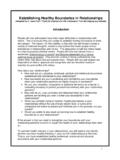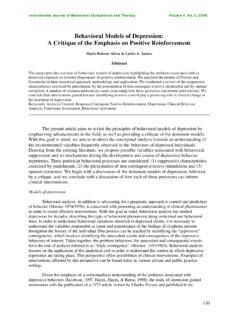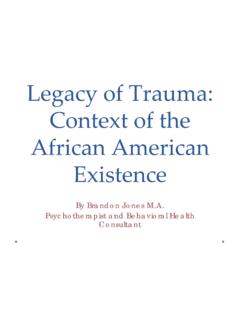Transcription of COPING WITH LONELINESS - Counselling Connection
1 ---------------------------------------- ---------------------------------------- -------------------------------------- COPING with LONELINESS 1 A LIFE EFFECTIVENESS GUIDE COPING with LONELINESS Published by: J & S Garrett Pty Ltd ACN 068 751 440 All Case Histories in this text are presented as examples only and any comparison which might be made with persons either living or dead is purely coincidental ---------------------------------------- ---------------------------------------- -------------------------------------- COPING with LONELINESS 2 A LIFE EFFECTIVENESS GUIDE COPING with LONELINESS CONTENTS How to Cope with 3 Theory and Facts - 6 Summary of Risk and Protective Factors.
2 7 Identifying Symptoms .. 9 Characteristics of Negative Thoughts .. 11 Types of Thinking Error in Depression .. 12 Conclusion .. 38 References/Bibliography .. 39 ---------------------------------------- ---------------------------------------- -------------------------------------- COPING with LONELINESS 3 How to Cope with LONELINESS Understanding the Situation To some people being alone, well for a short while in any case, is like living in heaven away from the constant demands of the kids, away from a thoughtless or nagging partner, away from the hustle and bustle of work or city life.
3 Sooner or later though reality kicks in and ironically they pine for the company and closeness of another human being. LONELINESS on the other hand, when prolonged, can be like a lingering canker, slowly eating away at your mind and your life leaving nothing but a sad and empty shell of a person with little to live for save an existence with little meaning or purpose. LONELINESS may be chosen, but usually occurs to people unwittingly or because of unfortunate circumstances. The loss or death of a spouse or a child can lead to terrible LONELINESS .
4 People can still live with other people in a house, be married and yet in their mind be totally isolated and feeling lonely or alone. They may have nothing in common with a person they live with , or they may be caring for an elderly partner who is sick, with a stroke for example, and who is unable to speak or respond. Humans are social beings and rely on each other not just for survival but for enjoyment and pleasure in life. Abraham Maslow (1987) developed in the 1950 s what is now well known as the Hierarchy of Human Needs model.
5 This model identified the most basic needs of people (such as food, clothing shelter, water) at the bottom of a triangle graduating upwards in the triangle with more emotional and cognitive needs leading to the highest level or apex of individual human satisfaction called Self Actualisation . Of course other critical social, feminist and postmodernist theorists and researchers have identified broader aspects of human experience since that time; however Maslow s model does serve to demonstrate how individual human needs require education, social support and networks.
6 For example, an infant would simply be unable to survive without a more mature human or humans (like parents) to care and nurture it. Humans have a sophisticated language in order to communicate, and rely on one another throughout the lifespan for intimacy, support, knowledge, understanding and guidance. ---------------------------------------- ---------------------------------------- -------------------------------------- COPING with LONELINESS 4 LONELINESS , when extreme, can lead to depression and suicide if help is not provided.
7 LONELINESS is to some extent part of being a normal human being. For example at times LONELINESS may be necessary for reflecting on life and aiding emotional healing in the grieving process. Many spiritual leaders have experienced intense LONELINESS (not just being alone) as part of growing stronger emotionally and spiritually. So LONELINESS is not always negative and pathological. LONELINESS is not specific to any age group or gender, so anyone in the right (or wrong) circumstances can be affected. LONELINESS can be short in nature or linger on for many years.
8 LONELINESS can be bureaucratised and many lonely elder people live out their lives almost alone with no-one to talk to each day and every day in some aged care facilities. Many older people also live very lonely living alone in populated suburbs and sparse rural and remote communities or farms. LONELINESS can still occur for a person surrounded by many other people in their lives. People can still feel isolated and lonely despite being socially active in sport, music, business and so on. LONELINESS is a state of mind, not necessarily being isolated from other people.
9 A person may have much more in common with some people than other people and if there is a mismatch of interests, culture, language, intelligence, social skills or abilities then that person could feel detached, alienated or marginalised and become lonely and depressed if the situation is prolonged. Severe LONELINESS and depression often seem to be fateful partners. Research findings indicate that social conditions can lead to people feeling lonely and depressed (Herzog & Markus, 1991). Factors that can lead to this state include: unemployment, financial hardship, rural droughts, bushfires or floods that devastate peoples lives and livelihoods and isolate communities loss of partner or loved one lack of self-esteem unable or scared to make relationships with others physical illness ( , HIV AIDS, arthritis or back pain) or incapacitation or debilitation, problems of ageing (strokes, dementia), mental illnesses (especially suffering from phobias, anxiety and panic attacks)
10 Or disabilities in which sufferers are discriminated against, new mothers or parents trying to cope with a demanding new baby, ---------------------------------------- ---------------------------------------- -------------------------------------- COPING with LONELINESS 5 people who are highly stressed or who move regularly from place to place without making friends, mid-life crisis (transitional change) and onset of menopause for women or retirement for men especially bullying and harassment alcoholism, drug dependency and social isolation ---------------------------------------- ---------------------------------------- -------------------------------------- COPING with LONELINESS 6 Theory and Facts - LONELINESS According to Michael Flood s report (2005) titled LONELINESS in Australia , the following facts are relevant about LONELINESS : Men of all ages are more likely to suffer from LONELINESS .













